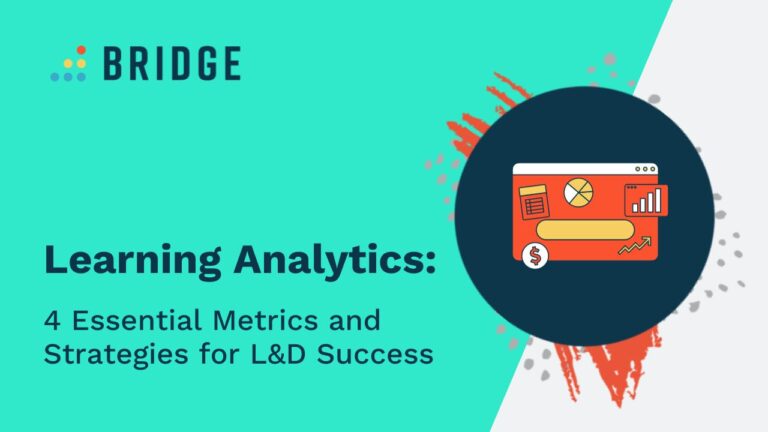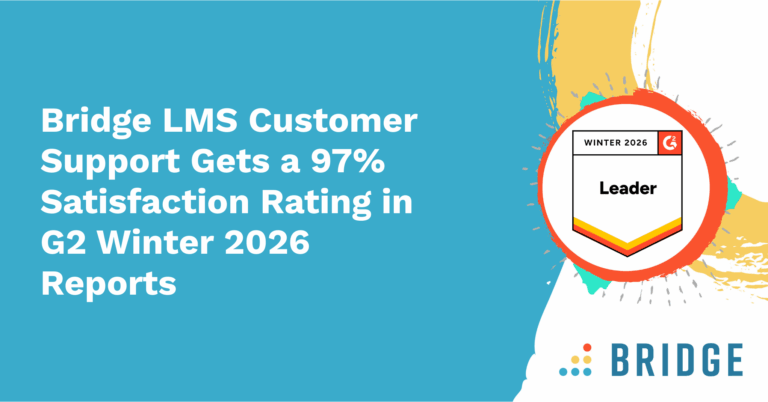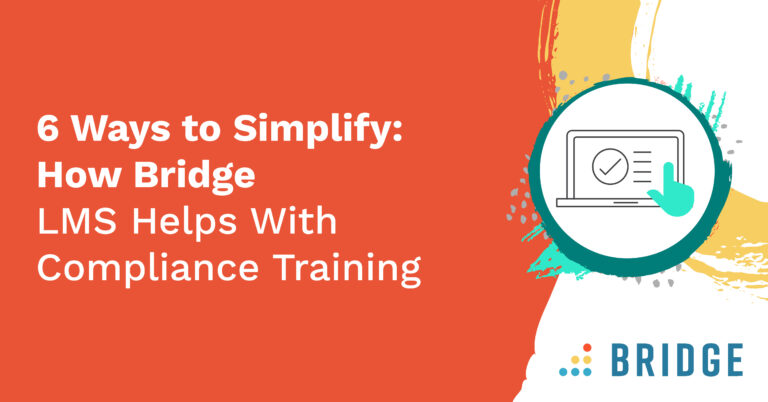Find out how to leverage learning analytics and which KPIs can help you speak to the benefits and ROI of your training programs.
For growth-minded organizations, the need for technology as a driver of skills and talent development is clear. As the findings from Bridge’s learning management report in partnership with HR Research Institute show, over 80% of HR professionals believe that learning technologies play a critical role in their business.
In addition, respondents recognize that one of the greatest benefits of using an LMS is better tracking and reporting, and they anticipate that learning platforms will play a more significant role in informing future business strategies.
Using learning data to drive measurable results demands a close collaboration between L&D teams and the business, alongside a set of tools and technologies to connect initiatives to actions.
The Value of Learning Analytics for Your Organization
Collecting and analyzing learning data can uncover an array of insights, informing decisions that make training programs more effective and improve the learner experience.
According to survey data compiled by sibling companies Watershed and GP Strategies, L&D functions that strategically align with the business share a number of characteristics. Namely, they are:
- 27% more likely to measure success based on organizational impact
- 25% more likely to define success metrics before the start of a program
- 20% more likely to allocate budget based on business initiatives to ensure key initiatives are met
Organizational alignment is crucial, and a data-driven approach makes it possible to unearth the success of your people in their training and development programs and tie insights to priority organizational areas.
When your goals and strategies are closely connected, bringing learning and technology together makes learning measurable and has the potential to move metrics across the business.
In addition to learner preferences and behaviors, a focus on outcomes can answer business-critical questions and lead to more effective planning, skills and talent decisions, and a better allocation of resources.
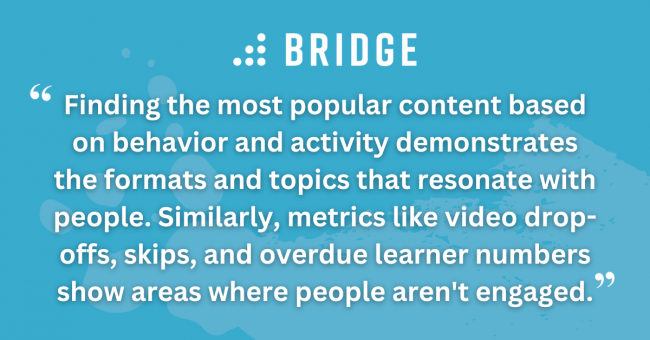
READ MORE ACTIONABLE INSIGHTS | ‘The Power of Learning Analytics to Drive Decisions and Growth’
4 Types of Learning Data to Track in Your LMS
To accurately evaluate progress, you need to track several key metrics. Together, some of the following types of data can reveal a wealth of information:
1) Knowledge Retention and Application
Via pass rates and percentage scores, assigned quizzes and assessments will reveal how people sharpen their existing competencies and gain new ones as they progress through courses and programs. It's also a handy way to test knowledge retention over time and identify gaps in knowledge or learning materials.
Scenario-based assessments, simulations, and hands-on practice go beyond recall to check how well people can apply skills. Your learners should also have a safe place to experience situations without fear of failure.
TOP TIPS TO MAKE LEARNING STICK | ‘Flatten the “Forgetting Curve”: 7 Ways to Increase Learning Retention’
2) Learner Engagement
The basic measure of learner behavior and activity can show how usable people find your learning platform and the relevance of content. Analyzing learner behavior and engagement can indicate whether content creates value and how people interact with courses and programs.
Common data points that are available and easy to access within Bridge’s LMS include:
- Course enrollments and completions (both required content and training chosen by the learner)
- Time spent learning
- Content views
- Unique users year over year
- Enrollments and completions by reporting line
Finding the most popular content based on behavior and activity demonstrates the formats and topics that resonate with people. Similarly, metrics like video drop-offs, skips, and overdue learner numbers show areas where people aren’t engaged. Here are some popular KPIs Bridge customers use to track and share the value of the LMS.
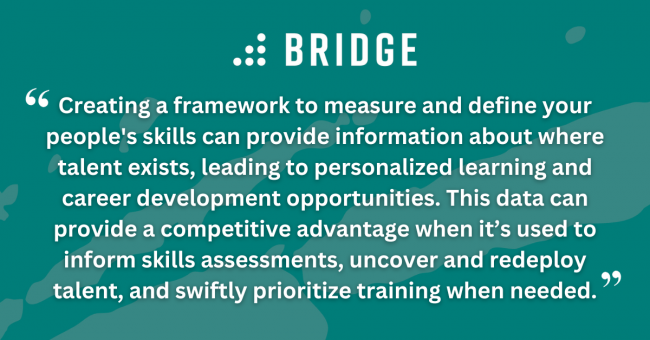
RELATED READING | ‘4 Ways to Create an L&D Experience That Truly Engages Learners’
3) Skills Coverage
According to CIPD report findings, L&D professionals and business leaders consider addressing skills gaps a top priority in 2023.
Creating a framework to measure and define your people's skills can provide insights into where talent exists, leading to personalized learning and career development opportunities.
Tying your people's skills data to industry benchmarks can also provide an up-to-date snapshot of the in-demand competencies and where they exist in your organization. This data can provide a competitive advantage when it’s used to inform skills assessments, uncover and redeploy talent, and swiftly prioritize training when needed.
MORE TO EXPLORE | ‘How to Build a Job Architecture With AI-Assisted Skills Matching’
4) Learner Progress and Activity
Tracking learning completion rates offers a snapshot of how people use the platform and progress through training at a given time. This data will indicate learner proficiency as they progress, how quickly they advance through training, and whether they choose to enroll in optional courses.
Reporting and learning analytics enable the tracking of training programs, courses, and live training, showing what checkpoints learners are hitting within journeys based on the following:
- Completion rate
- Overdue learners
- Time to complete
- Compliance integrity
For mandatory and compliance training, automating overdue learner notifications and scheduling reminders ahead of deadlines can keep people on track with deadlines.
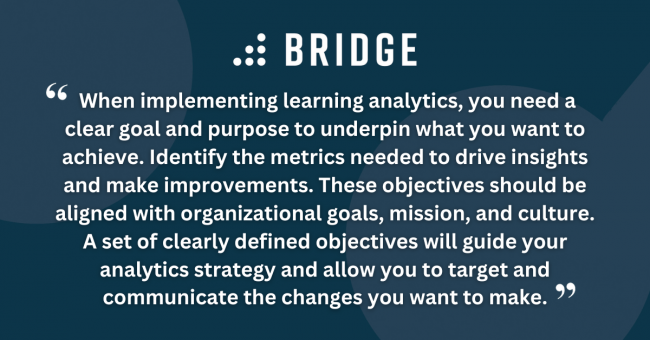
ADDITIONAL INSIGHTS | ‘Drive Transformational Change With An LMS’
Best Practices to Build a Framework for Learner Analytics
A well-planned and executed learning analytics strategy can springboard L&D programs to greater success. Use the steps below as a starting point:
1) Understand the Purpose and Objectives of Learning Analytics
When implementing learning analytics, you need a clear goal and purpose to underpin what you want to achieve. Identify the metrics needed to drive insights and make improvements. These objectives should be aligned with organizational goals, mission, and culture.
A set of clearly defined objectives will guide your analytics strategy and allow you to target and communicate the changes you want to make. Your senior leaders and execs will already be familiar with these metrics and monitor them closely.
2) Get Stakeholders Involved
Identify all relevant stakeholders to include in the processes of defining key metrics, measuring data, and implementing changes. As you identify those with key influence, you should also begin to plan out their role in supporting and communicating change.
Consider that stakeholders also include the ones that stand to benefit most from learning analytics. While business functions and departments are on their own data journey and have processes to solve their challenges, this is a chance to take a fresh look at your strategies and find where you can add value.
SHARE THE VALUE OF L&D WITH THESE CONVERSATION STARTERS | ‘How to Create an L&D Budget You Can Defend to Your CFO’
3) Determine Data and Tech Needs
Collecting data takes intention and planning. Once you know what metrics to track, you need to determine the most effective way of tracking, storing, and analyzing learning data.
Look at the business and L&D data sets necessary for a holistic view and explore the tools and technologies that connect data points. A learning platform that integrates with other tools and platforms can make reporting and data sharing seamless and simplify the migration and implementation process for your IT teams.
INTEGRATE YOUR LMS WITH EASE | ‘How to Pitch HR Tech to Your IT Team’
4) Start Small and Test Solutions
Collecting learning data isn’t a one-off process, and building a framework across every stage of the learning experience can generate accurate and actionable insights.
Start with a single data point based on business needs and test the insights, looking for any additional needs or gaps within the data. Monitoring these key metrics means you can familiarize and adjust strategies and develop your approach as you integrate more data.
5) Collect Frequent Feedback
Bring people managers into the planning process as you implement learning strategies—they possess great talent to communicate change with their people. They can also share their experiences on what works best for their teams.
Listen to learners and find out what's important to them. Regular conversations with managers allow people to share their experiences and provide feedback on your L&D programs and platform that a survey alone might not capture.
LEARN HOW TO FOSTER MANAGER-EMPLOYEE CONNECTION | ‘4 Ways to Create a Culture of Conversation for Your Organization’
6) Continue to Monitor Progress and Make Adjustments
Alone, data has limited value. To unlock its true value, it must be presented and communicated to stakeholders in a clear and compelling manner.
This is where the quality of your analytics and reporting tools shine. An in-depth analytics platform gives you the power to create easy-to-visualize reports and dashboards that turn data into shareable insights and automate the delivery at regular intervals.
Using the data, revisit your initial goals to check that they're still relevant and you're moving in the right direction. An agile approach to analytics allows you to adjust your strategy as you gather data and feedback from stakeholders and learners.
Maximize the Impact of Your L&D Programs With Bridge
Bridge Learn is an award-winning LMS that helps organizations design and deliver learning to their employees, partners, and customers.
Create, catalog, and deliver training at scale with course authoring, automated learning journeys, video hosting, analytics, live training, and a mobile app.
Bridge has helped thousands of organizations worldwide meet compliance, onboard staff and volunteers, train their partners and customers, build skills, and drive results.
